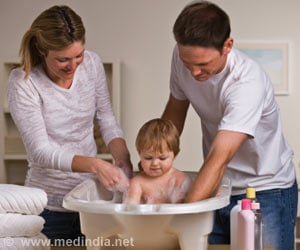New soft, safe, wearable sensor can detect the movements, strain, and force of the finger while performing different activities. This new biocompatible sensor could be used in diagnostics, therapeutics, virtual reality, and human-computer interfaces.

‘Newly developed soft, safe, wearable sensor can detect the movements, strain, and force of the finger while performing different activities, such as flexing and extending the finger and picking up weights and boxes.’





Harvard University researchers have developed a soft, non-toxic wearable sensor that unobtrusively attaches to the hand and measures the force of a grasp and the motion of the hand and fingers.The research is a collaboration between The Harvard John A. Paulson School of Engineering and Applied Sciences (SEAS), The Wyss Institute for Biologically Inspired Engineering, Beth Israel Deaconess Medical Center, and Boston Children's Hospital.
One novel element of the sensor is a non-toxic, highly conductive liquid solution.
"We have developed a new type of conductive liquid that is no more dangerous than a small drop of salt water," said Siyi Xu, a graduate student at SEAS and first author of the paper. "It is four times more conductive than previous biocompatible solutions, leading to cleaner, less noisy data."
Harvard's Office of Technology Development has filed a portfolio of intellectual property relating to the architecture of novel soft sensors and is seeking commercialization opportunities for these technologies.
Advertisement
"Previous biocompatible soft sensors have been made using sodium chloride-glycerol solutions but these solutions have low conductivities, which makes the sensor data very noisy, and it also takes about 10 hours to prepare," said Xu. "We've shortened that down to about 20 minutes and get very clean data."
Advertisement
"We often see that children who are born early or who have been diagnosed with early developmental disorders have highly sensitive skin," said Eugene Goldfield, coauthor of the study and an Associate Professor in the Program in Behavioral Sciences at Boston Children's Hospital and Harvard Medical School and Associate Faculty Member of the Wyss Institute at Harvard University.
"By sticking to the top of the finger, this device gives accurate information while getting around the sensitively of the child's hand."
Goldfield is the Principal investigator of the Flexible Electronics for Toddlers project at the Wyss Institute, which designs modular robotic systems for toddlers born prematurely and at risk for cerebral palsy.
Goldfield and his colleagues currently study motor function using the Motion Capture Lab at SEAS and Wyss. While motion capture can tell a lot about movement, it cannot measure force, which is critical to diagnosing neuromotor and cognitive developmental disabilities.
"Early diagnosis is the name of the game when it comes to treating these developmental disabilities and this wearable sensor can give us a lot of advantages not currently available," said Goldfield.
This paper only tested the device on adult hands. Next, the researchers plan to scale down the device and test it on the hands of children.
"The ability to quantify complex human motions gives us an unprecedented diagnostic tool," says Rob Wood, the Charles River Professor of Engineering and Applied Sciences at SEAS, Founding Core Faculty Member of the Wyss Institute, and senior author of the study.
"The focus on the development of motor skills in toddlers presents unique challenges for how to integrate many sensors into a small, lightweight, and unobtrusive wearable device. These new sensors solve these challenges - and if we can create wearable sensors for such a demanding task, we believe that this will also open up applications in diagnostics, therapeutics, human-computer interfaces, and virtual reality."
Source-Eurekalert










